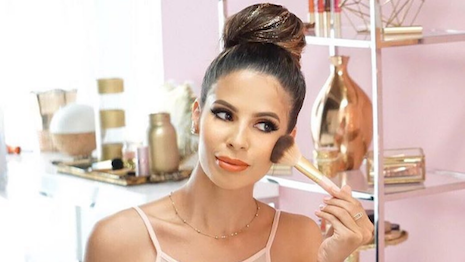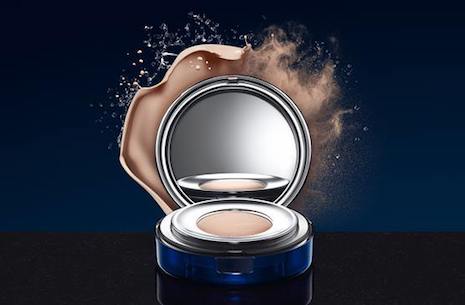Consumers today are placing a greater importance on taking care of their skin, turning to makeup that offers more than just cosmetic benefits.
NPD Group’s “2018 Makeup In-Depth Consumer Report” found that nine in 10 U.S. women that use makeup have applied cosmetics infused with skincare. Consumers are taking a more proactive approach to beauty, looking for products that will help them achieve healthier skin instead of using makeup as a means to conceal issues.
“Makeup continues to perform well, as our study found that more women are using it and they are also using more products, on average, in a typical day compared to two years ago," said Larissa Jensen, executive director and beauty industry analyst at The NPD Group, Port Washington, NY.
"At the same time, the consumer mindset today places greater emphasis on taking care of the skin in order to prevent flaws, rather than covering up flaws as they appear,” she said. “Consumer expectations of makeup products have heightened as a result of skincare’s influence on format and efficacy.”
Skincare meets beauty
According to NPD’s report, women’s top reason for using makeup continues to be enhancing their looks. However, the report found that consumers are increasingly using cosmetics to even out their skin tone.
Compared to previous years, more consumers are also using products to feel younger or achieve more confidence.

Too Faced collaboration with vlogger Laura Lee. Image credit: Too Faced
Reflecting this, many women choose products that offer benefits such as reducing redness or fine lines and wrinkles. More foundation users are also opting for pore minimizing formulas as women seek out more flawless complexions.
Sixty-two percent of women have opted for cosmetics that moisturize, an increase of 4 percentage points from 2016’s survey.
While women are choosing formulas that do double duty, these products are not supplanting skincare. Instead, the majority of consumers are using skincare and makeup that offer the same benefits, doubling up.
Some luxury beauty brands have fused skincare and makeup.
Dior originally created Lip Glow in 2009 as the brand’s first color reviver lip balm. The mango butter-infused formula provides a customized flush of pink and 24 hours of moisture.
A popular product for Dior, a tube of Lip Glow is sold every three seconds (see story).
Chanel similarly offers moisturization in its Les Beiges Sheer Healthy Glow Moisturizing Tint. Meanwhile, Estée Lauder's Perfectionist Youth-Infusing Serum Makeup offers anti-aging properties such as firming, and Lancôme's Rénergie Lift Makeup Foundation also promises younger looking skin with a line blurring formula.
Chanel Les Beiges Sheer Healthy Glow Moisturizing Tint
Skincare labels have also branched out into cosmetics, tapping into women’s desires for multifaceted products.
Switzerland’s La Prairie recently launched Skin Caviar Essence-in-Foundation, the first compact foundation infused with caviar water. Reflecting its skincare focus, La Prairie debuted its makeup with tips and tricks that centered on perfecting skin before applying cosmetics (see story).

La Prairie Skin Caviar Essence-In Foundation. Image credit: La Prairie
Estée Lauder Cos.’ Crème de la Mer also introduced its vision of beauty beyond skincare with the launch of its first cosmetics range in 2016.
La Mer’s first foray into cosmetics used its skincare expertise as a bedrock in developing three products and two tools. With a cult following, and the cosmetics industry booming, it was a natural progression of the La Mer brand to establish its own line of skincare-based cosmetics (see story).
Beauty boom
Social media is catalyzing growth in the $237 billion beauty sector by fueling consumers’ interest in their appearance and their desire for self-expression, according to a report from Fashionbi.
Makeup, which saw a record growth of 8.4 percent in 2016, has been the main source of the cosmetic industry’s rise over the last five years. Fashionbi’s “The Art of Selling Beauty” notes that aside from makeup, digital is driving the sector’s acceleration, as more beauty products are purchased online (see story).
Within beauty, prestige skincare is behind much of the category's growth in the U.S. so far this year, according to NPD. While cosmetics are up 1 percent, high-end skincare has seen a 13 percent increase year-over-year.
The global premium cosmetics market is expected to exceed $126 billion by 2019, according to a report by Technavio.
Over the forecast period, global premium cosmetics will grow at a compound annual growth rate of 4 percent due to the high amount of new products introduced throughout the sector. Customization and personalization of fragrances and skincare products have played a particularly large part in the sector’s continuous growth (see story).
“Skincare has created a winning story around ingredients, innovation, wellness and great skin at any age," Ms. Jensen said. "Makeup brands and manufacturers are tearing a page from skincare’s playbook by leveraging skincare positioning in their own product offerings.
"This is a step in the right direction, as I expect the interaction and shared learnings between these two emotional categories will prove mutually beneficial,” she said.
{"ct":"S\/QZeHRWYH9Unh7siX1OCBSUwgcxSB++Lr4LvhG9W2jO3Uk9QaMTleIxkm4B7rjNbhlJFdf9EP5xA3scZln+pw6V3BhX+Q1VGq9bW7\/AygHjSbUDOUZEWGAKqVDiaISl1ATJGC9nTh\/SFXzJQasPS33PMd7VLm5h9ZbKXhxVTi8tJZbfHxDYpG\/uRGCR5F+ukVtwusgCHvQw+5AlR\/0RMSQJcrmvXR3ogLu+NfNHH27xbZY4Xy64bTjCzi\/zMCQKSgb4McGrCrLinlWntD2lbcku4ov00PSuw8782muyndh\/nPLCPF\/1xz9QxjF6G7eZSzSzPpLD6b07Q1MS+d8ONIN1vAgvj5ZAVSDgSbMKuxr6wtsiUTzpeQQpMoM0PPWZ3RgcOkl9gh78ugxgBhXqjwQ+WyK5RG81aHFuO5wgNT4h8S9V1BqwZIAoeOx19iwHf\/ySayFXEARy5rcNW9lJSvwjGkJWghRJwMy6JoX9iTvqShgWW\/TJGmVrWRtDFyB7\/c97yTafXLJ1eeMaCV9oBFiWQuQAtExuqR1ukwiyaDeKmA+HbG0Q93ZC93r84M8GQoFnPkcwpWj81+3Bjfd0IvQCxD7kwmIn+QWAlb+kIUalJsM6OeRWPKS0c9azepmtm8P2X4ZDrQjkITGsdmvGEF4P9JZdCGY0+tkek5xenN418JOmgzPeAQsww296D8fLYJoKDcCJF7w+94Nd\/mtKdGbjfIj7akBD5iPt+q42pKvD2G1HfJTBBBSlNJK59XczXkYVhYQinqzt+1Cjm+BgAd2Sihcr3fIF+WOjZPZgUACE6iu04G\/lePM6s7xhXbK0zzv+b\/GKg+MJIxqbU4wNicko+hUfCTzpUhU3lsIVJBnh1uIM3SYER4HCTYpNmq\/CLSlQLj1FhdYWaeCeyX3qlozGDipdCi2eQaS2De8wqW5nZdIC10rlAxicwApv7PiZc8IC0DfrBwkghLiPoE+Ds1b3ARhJY7jGZfUUxhu7KHfyISyxicWCn0U5j9dQe6h5y2CPfgrohiNbcHw3Fp7CyEMb+VAhA+qlJtaGqncCSINdD8tG3A4WKuELafF14Z5LDgBhX2+1WXrggi0jxloX8D8XIiN8Cx74DkZ2xJ7uR1eThzSl+qUHY3MDILNLgpHYdWqRp6g4A0\/kFHfrX\/hJeRniBuC1obw8pCUktEwpNE+hTe0MF60nFNVDo3TQEoJYP+PzOaGuxSGGC2Dqx8Cu9pFS8vhynCwQBA1GjDbxyA0aZfe15qfC1Ccuu0H8BDy\/T8uccYLQcIhHRoE5PqWV1vlIVMpnbCugSgXzNa4kfZ5+R61bhDoCb+WvhnKCFxXFYQ9sSFKCt8oKyjx\/9PE+YNW4m8hiIX4GZF4piNd3bnxLUrYxaRiwcdi8YlDIQhIWF+khdupiE9DL\/u20i5FJwcSWMsBZKhet398PkFLEBrZ4QpC6S15GyYL3G5AhRgPeF2tTcIFPvq5lRmtgKQC0kI1kvNFGY619JH+9t2F7E8v3ZHwz3LIzAeA1xK09nfdiyIRyNnTA\/oJlYTjUYe6tPwGph729xPzz7\/MglMqKt98dJlaMaSX3pvvzbhuf\/\/ilO9GuKNqnTEVUmPB+ooA9qT6xghAl2YyeGS8ejXjA6RGV0ZAGoeR7HmHB6g5u9KGCjD5jyTg2NoXQZVKAKVN7W1+ESSel4vZQjVC\/97a4QGTY7l3xogbRybyDerNa7iDzSSTWelC2zqReQmDsIfg+RxsYAjYaKXdUqUmMdaUcoqS+rNiJWv9kz7nX4X5nmsEOICUHDuiTdKcswmfrz5KS7Qs3K168p+NPLln\/1iz8nrBqd2+KA62iJaTWc3OrnC2E4i5eCSJ4yA8q20uVSepgPeSgpUN9LO9grfUelG89gFrjVFy4VuIlKX9pNdXVaViHUjX4kJiASzWIYpxCh1ir4HaNbSYIbdzOYD1Hj0ej78sTgnZN1VjK8sAKwKOD2NnmgDskbICkvAMCgGV0R\/bJumcODjAYSlzyvldCu9iqM89Z9Fns2zIUUmXEMJpkE45Ec8\/nkpkT49A2j7Cr45sCCjdIUIkbp1XUxjuTgZbW34e2S1nnNGEqkMqLtC\/KqbLBioxbeOd0Ju6v19g+zZgicLePzhWFM\/Jyvc4rjvym1oR0PT\/xgDy+oJDwTUE6ERhxB+wQZpaz6QIici8lh11iDnfYNxsp3W8A2fp5Ee0BvRb\/1GzgvP5qa8JkjOdY2Jj8SBJjlGPKcJTJWTlFg5GcPMwiatckndbEPDIdOdvuRmh3qTmSY4YZ3Ga37W6plF6ukmZd15WyrRhJNaRnvfgJzWCh09bJzVA7MTZavzb5oe2iZaNOMQVUPVRW0SvNmDlV5vvkumzEhIeBSMAIwbN5iS52F3A9RYhK9x2N\/0NfBncWw5xRMy2KDTLMmMDZgAWwTMD5fJGrttNatrec2CiXwXgCBPl6mlkOyj9prOoRD9lFZckbgIdvzxK7VhOiSbrHtwiPloZIIPlFYZjz\/k+HE\/2HRJunIpog1ebnU\/TzKjj2tB9ZO7O7wY216RzCtwVuEmf\/4y8lJE8hZqrIP2lPghZVKgmQIS\/zmVza6T0pXrC4KIwNDlogiFICVcX\/8DwdBx5jG+b03\/b8++bX0mCFEndW90wzVnHywYpY\/6roMRdTfi3C+w1T6ddl4x8LbHKcGHj40dN1kZYZBRXDOHywmGSK1cT1+b6\/to554yGyFR9l0nq7HPcLb50nGdJu46Mt6wM8MoGMWLrKjK0QqAEjb7phzcX11o\/QloiMwLtEr\/8l9I6QDbRrcKmz2vwbbeFnC0UApb1gnAkGuPedUMcvsaNYo2px+Za6s7nOba2dzzVlpVhFUtep9rTuoLLOEoCRQ8o9ouAcV+gnAEPz+n7f+Nx6Zqf3Fxb+uH7h7D5NV8Ya5+QnJa7sndu4RxX2\/Kxrsrl\/mZRRzVM0awFrbmJW3k4\/Q\/FV+XKVyw42L9eVSXoG543BDW3QjSNVyX7NP5bZN54PASSgozVsUf1Dd1ifhyPiMukiKygnaKaowJLvexvRbUHujn6HEA3OoWp67HPK3LE4sC9gkRtVGbjLv98ROJbhHbWeNrw8zb\/KFK24AgTS641WlLeW6gnTiRqgfehE6FeOI26xVWV638R4Zbr2o3z3KyMYQ1YH0ksEA+kBlKgJgCZXqVE91NkHWUWlgId9+uFoM6lCu9JLN5ib80uQpkravwoPpwKHqmfabSMVBK\/t6IIFgvAZnlJvHSULlVW6Z5qZDK2qcVU\/uDPupWaQ8sHH9XaNnKLFGlO0f0EOvnOCpL7bxlllvh76X8qA2nCm5hDmNP\/fLpJG0upliPgrKZ6gnVmqn\/hG2EVijUin2a3BiP9Gzn0RCEWxnf1MnozG1p6OZqFJhkDirtVjenMiXhQZNZ0pzrjy21ZUAUOFOVThgVc4SHf54bjGSBXFh+\/48wRNx5xOf5DrVl\/7mYaCvHhZWUFgmZSandxxvQUeXB4NgDbeGGqRvLfgBclRFXlc8R8BsaNgcFo9mCUAVyQkDNT62Ok7Er2KySBDbhAKkV+t+OJp+HSEKRYYxb\/wN2EqucyCh5MYKGKW61oZ73dYMgeGTKNIt\/py6yEx4U7W9jWDKA3O5XVyHDU9lCeNai\/AoxkUfjuCJkTea2WAeOLixo3mtER58Z1ogqyDTkdz9FfsDy0kdAiHM71OBcd4Qyj7TVkB3lpBg\/2bYwqK0jgFMxh2xjwSpwPQG8TtmN+NDaC4aWFoqfuZDMmV+Lkt4pvpIm4vcELqhk\/\/nAgEbw2hkaaUKXA4D3azLAbtCJ65fnVqSI5IK1Y5c1MVJ41P9kfqIC89bTHycveQ8L6\/jYzyvrWK8LKDXk8RjVk\/ThLva3b+HO3WXe\/9Em0mwSw1ZScPWUuREMmCEJTv0ngEecuzpOZLA5dwn8Mkn0OcH5mWhFkcH67q\/HVKEaKaqM2G\/w16WUlNqPC4HUUEH5Ko1lQjQif2Z8XvQICQXpcHVDscGspnthgnQoYwU7m5mPlqTQaUZriSU4WGOnJEScLZ5soOgXr+S5Q+7z8sOWaJvqrFipwmBWWqGzOpO6YJXegCzevZvu4XpUbQyZiaxvODNFgsx8q0gV5G9qKgeRCibu3L8nA486rAQY42I2uwQbFoO+PBpH0SFWLuo3Q+fMD\/WFopmWWJDZTPxdijKYFzWd+FsRURYL+pluEhBhkpZEIs0Xnn9bnOOM8B5+kyO3Heo7qokC74GGtU7Wvaj7QdqLvC9WOp+GalLbWDFPWaiQEh5s7Yp4tKF+YP+X4c6uBrpq4Rvlpfk+h+DQ+7xuuJ4+KLLObIht5Wu4D7sQUuKelFQufxIjflH9KzGe4gXSKXUPQIN33TlB58FqNJsrOWfXZJ0pU+n907H76gJUvHNsoDNWuyz7FamUMCstzevRm\/N3k5lX\/FJzj49bf7sKnfVn8H9EZ4P\/leVLL9SFa1O4SUG6AKA\/\/5CC0UKg3neWqdxVejmQ\/qKGD2rDv7ilqzsQFDftteqSjhiArWXLUZpnZEVS6jqUXRTG1KEgqrYNSG3kzaQjkVx4jjswp41ZSJ4BgzGSKze4LlPmS9rREDQpOnHZ5KcsGHW5Xk6O4jDGGxuy8fNCWpsawIHFJvr9VBGAUZrJe2HQbsh7EHByHhiVCa5eBg4c9PbD6iNpWtF7W6ZprqakYIUaA6yytarI83XW4Ufw6Fy6iyepy6yjBJxiC6Q8sfYRVHgAiyLb7pKBhTr\/X+NNUNGJ+K1BwaI0gBinLS\/FUOaqfyr3XiRaub3anJ6CrvsckSiPpFytE\/Rg3SEKT+X4LzNPkOVExvOgdg0g74cbNBSaha0o3+8GJecrSO4Ppt9gaCZSwb+NxYQp5WYVdLoy6Su3t2\/GMQIj2j5+NUtALaxI\/6czOPlj5FF4Ua75oZdwzNkFeDNtyyJ0jKYjrqNSY1I3JDxAqXGtPLn+aXjwCIKPsQ+gkmdw5SI5gCwnMdQcQMmMdrDX93tJMTm9k1xhqKR\/KzgkhG46LGEpI+h2h4LUFaTaM+7gOVPRcVclVjCOBWlnzHokKZf+Y+r08+sU0oIn8YUoEd4Khqz1KsitE2Q3tn+tlhO8Vxm25Vod79L7slzT4BwiGjEcuh753QOWU3FFnO8hmxUX0S4RtXcqwC01410iYJS378vd8T4comsIOa+cIJTYdheF+bGHC0vtXOJ\/q9ozx5aCKwvg\/So2KIPIr57irjejMPp9EdYMocv7REOHL91nGC6tGuw0vrBtVKsAp1H6p2645aN5EnBBWw+eFmJ7DjU4pjHkbWuBfgquLbRB7DQGj2N\/UrhLubMAXWHM+6TjuA36L+lGqnUAhPgfsXW1AbI5hRNxXJVLJkKSga9jypU5JZYKlUx+Z1WFBWAqE12o0Zjplnort+vOHdF8WrKF6wD4x\/sNKJD3JJnr9\/p7VleI4dQPHAs5pZcxFKShTq8km14GycyzLAA9HSnWiAC1JUAEaD1pGtVzUI7GEMed3jTkia2Pq37PXUumoxCMl3f+FfX2bepRqfds6ONnXgX1g1hG51wAba6vNjfZRYzj3v+qbOl6KfoWzc9Sr7m6N+4\/uYJvA4IdrDIUB\/Ldmi0ZcY5PVHv6iW5qS46kWzOARqRDkzcM8baqG+4Ylv0NAyHKnQJRlMLim9sbcyqlJEl2i3fX1eJqSOyfJ1KjqaYwGsvtV8DzvgxdkHXgj9WIgnKnRwa8OUH9rJw2MAiIqdw0C37YyF6B7l6YnCdIWC9+j6bkUKFYKkaofTU\/2TgquK6K1AqDfoiiB71jS535z6ZXBuwuSSfPIbDEEtlMVZgrcjZYSbFsa4E9t4VJfS8\/KZhTa3HA1Hkvla2Vl9XmEPunUnczz069KO3N1\/YDMu01Scv0FlywHExFiLXapQtRHbzwNNYix6LIu3i0d+GxNkxtDYUa0DG4jHkMyO7uyf4GP4FxIzUhRyJascd8WzHABEZvbyD5yqeJTnqlfMIKPyFFzYKY9fhoDICfERVnOgD7bAp8zWktI7PWtd+MSgaVIrv40SDpIDUHJMaZKsru\/2PZ3wyQFDd5emDcXSYY55ZHeL5zKUpdh+OYXZAPE+3NsZXztUH9lc0DmMnPo8OWyicqk4ssOM8bXFnot97v93zBFiCyncJK\/PRHGDUIvGs4CwkiK3f\/0hQxejOmRm1meD3lI6VWpqYjKf57+L+HFymlk+2VuQXNZF+1gG3nJlI5QBP\/9S3Bp6nESlOhOF9q5HvxWYkO3ROETD+hZsUTmiTtSSwDxEl52oh96UCAvOqdZIgX9dAwTUGRRhsfFPdqfe6LLv\/17aVLEuBMsDhtafxlDI6NtWE3yoeHKJHCsu\/S4LKU9wT7zJ9wvQzVyDDzDvRnEHBl+D7Q58Jh8+4vK2qv+ov+ugxlOhxOs\/PJJ+Lei70QHFRbdrhb2lQbh2E9QjuBGUnGr1ZJYuUDdcMTfKGgfUcRrauWU1gYrb\/\/kwkv0btbD6WEsmz7WP27FMNZc77y6flENJwwCl3+zjvTUCsqJLVWsl0b3ZwWPbu9HL5kuXSrmnX2sstmR6+ApZIhgOR+iw0P\/ptZcK1T8elY2lu8sHZbMDFziG1qXp19QA2IhOj2P6XJkg2WXpFIzOzWN+ysKV8rQikcSFS+VR586U+duKYySU9vsefpcFMzNJxr1KGBwp3Ibeu4zBwowF0gTnVqyeE\/1nfYkSYQC\/c5zQSFugbPYCCFwT3iqNTw4748KPF7DquSSyROi6QGqYx7wARK3unHvcPUerX0tND24VX7\/\/Y+17fYpQsDOyQvESEHFyxyaOwmG7K8GU+7F176t\/umyyYT5netn0hdc1+TyFeEm3tlyckR29EevJIVyJNbMO87qzGr\/9sybkWsT1sLO9XNGUh5F5QMitl0BtgONgMkbVUQXOiYDy6ZIvCkAAkFMiVkw91Vmsu1ACuCKMg8dNy4bmIQCE\/O2a2hxkH4Bbgu3iHJMBv9\/AB8GgCrv+lTRkBkyQ5iGmFUoKlf3qH1iQGUA\/1kgzvU\/\/zISbEm+PSNF7XWT6nk7IDoDDF82figI9Y\/4H+aCbFiaYjQ4QMwCiwgA48mMa0pykEfWDwqAooGSC\/sC3+U\/T9u7reAfH6\/dxMzzZ9x6HNuleMyezleBiEGXHfCGrnw5eV0wUTANBXzmim9ovmYnHFwtXu0Hy+OHwlpJX\/X9aWej1W\/6XIHtv4AVDkonlzAZ0jeGnKEYIXO9pwWufcAE4zMGE3HGht9vvfDLbq+ubGGS6DN1CkdPUNSCdx260+6aE6FwEdZjU6Qmx20uHExFw4g+Qo+xiDhcGwf9JCoRK2vG1iDBZOLVkhKB+GeVdDOjxwESxS3kd9KeX+Tv72ZKX94AlW5ppsHBgxpJMd2uyV5sdggjEW8XnRqLtj4XSPro9WURgMsFFUocnjRyQ6whllm86gerTdCwp9vDPJwoQw62SAwRDrOi\/jOR0\/v8X1JUfpbN4H97QbHAqVMCkAppYcNcFBarfNYXRjLQgIKAxwpb8W45FW4bllve+cX3LxJFCS2prGgdOARf+owY304OX6R8x2NHoctEg9dTUGvPdcVJp1+nAMwzT+33Xsuh23o1\/Umi+fcN+6hAnuJJXYpWZ4M3Ck4LlPQ5iZbeM+jw6pUiZv9XH11iFDBUCE+wFI3gyT741rD7mE029UEY05L8lEnVMGwdoqAdyRm50WMmEInbX+ymV4LZXid7T+WBBc6aUPOu7xLOiDgRqYKJlbjA4zSrVnkjxcxUODrBSYeUnv4AHjpnzBlHDgSSw1pz5Ik9iPauZUtQyCgthbYHYxYa+Jg\/k+sgnMFOrL828QDHnduKPQErtgZQQnb8xeim+ctqVAis80ghqw3H9cINf7wAFvlKUXyOSRmqo5GGkIuey0VhO3KKVHbMQu6MxOV2\/rCMvTujvY11aFYvJG270PVJACs1nbWw8URP1sjhWHljD7QtfyT8BmXQxcmY7vjRMPf2Xzx+Vr2MEk9JztW4kc6yar5KQOnAMte\/vABL35h2k\/qMp\/vBd3hzwp3tml9ogXOG+4tqdslcoJSWJ1UaTGikTuqMTeYL6uMDj6GKCjrZJ8+OprFoFMC\/zGCpt0A9sUp2nc6k\/weXerc\/cTK85k1ceB8rySrOYjfm0J0zDhzQDOSCRx9SiEUjNHgOe8ciLR8PVTrXATz0oxgOj0Dj1K91UvQMJzKkRax+jnTx6R+QEaHp2nFS8z\/K5aobtQWQnhqyyYW6W9s+HyiEqk9LXNiiTUGduCK3XgkSXvv\/V5EwCD2sZR43+tP8Z19R7NIZ10tNV7FoNwSkVsvGFm\/r0uozwQ6du12akF9qpKT+mTl1advksmlr5z8NcLs8zZPCSWPSMc2I3PBF0JCo\/PCdkaznYLbb5tsS9mqERAiFOwg9hmwKiPzLjcKYYc3CeOWLGdJd0BKVxa\/jAIYUCZcpg07H895S1Y2eQxehTfWvobSYsgLVILNJGlCMGLfLlLndYs6RPkCzT6RHhotjsaA\/tJCjtqNubRbQDtPM1abnMRuKXRbqJi3vpbeV35yLiIMG1EaLd+UyeqWq6WWO0WGSvgChjRYFlccWre+BJSYztaN03pqY5iALpEnaKhkLD+gmHDEafpCJ4X0AP8Mjxo6bkhowGWzzYaWdcrmbCXKBEpFLWuoEZmLzD\/ndb+0fpVpU\/Ru5rMjMiZsPnwIhT0ssBpuecw+Bzxofsb7FjfDpiofrgzMnglSJr0qDIKvgyWv6NEEhUraVEYzH5oq7UwNyfQPD8QPcIT\/HEPhAG5Oicg6GVVTiw5K99dguQM1hZXLvMELHP\/pWoWgf\/rtiMeZdeJtRLixZroOuGk0u0QKPa95\/VMSwaMtnxWvu08EgYQuBpivn+om9v7DOtdQTr\/CMByXr\/Eg8e6EJglcQudgFTPxwJHGV6qcGyLx+2+7YvVgvjp+tbWe8wmpPM7B4Y5YInPtanCRiWwhI5Uac2TJMcKtOrjsygvLuzzfQZQ4Jybw9cUjqm0Pab27jSs2RO5c7+32AOMSqueXXfYYHQJXpLp6d0hy3mqg8cEAS12sVeC+FkYCpbSM+25VzPL3AQEiZO8wXI\/rydeYS\/4DYysFv6nEwkPrzQoVQ404\/Lmfkht+iFEGTwaiXEAclaULbg0AQ\/bnLN2\/HIJW0SfE5EMgQ6toMegf42QEcDl9uNfrG+C2ThXo1Adlx5R21gsKI4uwg535mRw0mp2d4ISKpg3feLDHXKEcsVMi5BKEMuGtL2C7BhDnCPENgjmh3nGvWshaYq6vSOM1VHSQvCE95ryjwkJIWP3+OwPDVgdv2ns5Kif+URXNp\/51HZzOGSwlKwunSneTOaIhGmo\/Vti1eIuOdhKcjpK5vh6JYR+P5B5pPiQeFDxw2AiJUUZ5GM8CqLoMYqpnxHJWBqwNPn8PjQOm2oeSYnGgfZ6PsyLHMBlzLxQMMMjR1cd8s7MDSmylJx0qJTyR9ucZoKkD6zI11KqPpsDQGr7ScCQx0HTGs0v62CjgSNR+R\/mjqo1jop5zQU0MLyKDWwvedKZw\/xC+ZptM43cKTwAgN8lbEEJ8JjWL6sBXFLxmMOMDMB2eicfw6Q3ptb2vB7iXCoSCdAOYZiwqogNOnQlP4YD3Q\/SLYp5LXGVDs2RQoFaUZHbpzbuPO8m43Bj7XELwQkHbluzo7Oze62CURq4Ck0Asb6yPFLXuilJqUYBU+4HiCMkEXeBasgvotxHncSVRdz+UXrWpqWXAmLfh1AAWVwx9vlsuMqcoRhZUGWih4evRAqfaVfWrIoS0PhDtBnI+LEXzqfTi3hYwUYV1RMG95ycAdXQNsPE+Eqf1Z\/pXlqxV6rdpSTNGs2nMoSR2Imv4YHz3xWEbIlKN18mWKnv4iSmxEgHGXcCUWqGl9KJrXBdwUiZadNgub3\/BdRGZiCUoG2uuVGsnnPronGP78xVTExPXBL\/y2o7EqVULU\/u7zmMQgcZL87317pzNM5oLqrCBVo8SdL7TqqWXk0okofb27YRj0KAGyzrKrxPNMxLWWdDJNn","iv":"31a14fdb0649acbcd569185ed33afe70","s":"47be4e93de1d5f95"}

 Crème de la Mer skincare and Skincolor de la Mer products. Image credit: La Mer
Crème de la Mer skincare and Skincolor de la Mer products. Image credit: La Mer